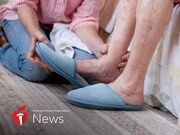

THURSDAY, May 7, 2020 (American Heart Association News) -- Melia Wilkinson cares for her husband, Kerry, who in 2014 had a massive stroke.
Today, the 57-year-old has no use of his left hand, limited use of his left leg, and relies on a cane to get around the house. Kerry can do many things on his own, Melia said, but she helps him with daily activities, such as dressing, and manages his medical care.
While caregiving has always been challenging, the era of COVID-19 is fraught with new anxiety.
"We have nobody," she said. "I worry if I get COVID, there isn't a person who could step in."
The couple and their teenage daughter live near Seattle in King County, Washington, an early U.S. coronavirus hotbed, and far from relatives. Since the virus appeared, Melia has discontinued housekeeping help, and social distancing has put their small network of friends and ex-colleagues out of reach.
Normal support systems have buckled, said clinical psychologist and health care consultant Barry J. Jacobs. For loved ones who need help at home, longtime health aides may now be unavailable. Or families might be torn between allowing outside aides to continue care, risking coronavirus exposure, versus taking over that care – or letting the care gap go unfilled.
"I have seen families struggle with all of that," Jacobs said. "These are very difficult choices."
For loved ones living alone, whether they are safe and can meet personal needs is a crucial test.
"Does it seem like they are eating? Sleeping? Taking their medicines?" said Deborah Dunn, national president of the Gerontological Advanced Practice Nurses Association. "When the medications are messed up or they have a bruise on their hip, now you have to make other choices." Those choices can include moving someone to a senior care facility – or moving them out if COVID-19 occurs there.
"There are no right answers here, and in many cases you're charged with making the best decision you can among bad options," said Jacobs, who writes about caregiving for AARP. "People shouldn't beat themselves up later for things that didn't turn out ideally. We have to accept that we're doing the best we can with the most love we can muster."
Caregivers also must navigate a radically changed health care system.
Under stay-at-home orders, Melia had to cancel a half-dozen necessary medical appointments. She worries about access to her husband's medicines, including a seizure drug that recently was sold out at her usual pharmacy. "He can't go a day without his regular medications," she said.
In routine care, telehealth is filling some gaps, said Dunn, professor and dean of The Graduate School at Madonna University in Livonia, Michigan. But COVID-19 lockdowns have shifted more of the burden of detecting and triaging health problems to families.
Dunn advises families to compile an easily accessed list of their loved one's conditions, medicines, health care providers and pharmacy, and to monitor supplies such as glucose testing strips. "It's that preparedness plan you never need, until you need it," she said.
Caregivers also have to be vigilant for COVID-19. Older adults or people of any age with underlying health problems, including lung disease, serious heart conditions or diabetes, should get medical advice as soon as coronavirus symptoms start, the Centers for Disease Control and Prevention says.
To avoid bringing the virus home, Dunn suggests caregivers take usual precautions plus cluster errands into one trip, then follow the procedures hospital workers do: Discard disposables like gloves after the last errand, then wash hands (or use sanitizer) if possible. Once home, change in the garage, drop clothes in the washer and take a shower. Leave shoes outside.
If caring for a COVID-19 patient at home, the CDC provides extensive advice, including fluids, rest and medicines like acetaminophen if helpful; avoiding sharing personal items and space such as bathrooms; and disinfecting "high-touch" items such as doorknobs and faucets.
COVID-19 can arise subtly – perhaps a runny nose, Dunn said. Changes in behavior, decreased appetite, a cough or growing confusion are among symptoms that warrant medical attention. Also, in elderly patients, "we don't wait for a 101-degree fever; if it's two degrees above baseline, worry." If breathing or mental status declines, hospitalization is likely.
When a caregiver takes a loved one to the hospital, now that visitors typically are excluded, "the advice I would give is, say everything that needs to be said beforehand," Jacobs said. "You go into that situation with a lot of fear – but also hope everything will be OK."
With the added stressors the coronavirus brings, it's essential that caregivers seek help, too. Wherever possible, recruit friends and family to get food, medicines and other necessities, Jacobs advised.
"If you've ever hesitated in the past about asking for help, now's the time to put that aside. Every family member needs to understand this is a crisis, and we all need to step up and do more for the people we love."
Relatives can remotely manage finances or other paperwork. They also can work harder to be in touch. Research shows social isolation and loneliness are physically and mentally unhealthy.
"Older adults in particular are more prone to getting depressed, feeling lonely, not being as capable as they might be if they were feeling better connected to the world," Jacobs said. "It's important they realize they're being thought of, cared for – they're not alone."
1127-74-8,1,2,3,4-Tetrahydro-benzo[b]azepin-5-one
Read More4038-14-6,(3,4-dimethoxyphenyl)-phenylmethanone
Read More2338-76-3,2-[3-(trifluoromethyl)phenyl]acetonitrile
Read More351-35-9,2-[3-(trifluoromethyl)phenyl]acetic acid
Read More2997-92-4,2,2'-Azobis(2-methylpropionamidine) dihydrochloride
Read More95585-78-7,L-Phenylalanine, 1-methylethyl ester, hydrochloride
Read More20324-87-2,Disodium 7,7'-(carbonyldiimino)bis(4-hydroxynaphthalene-2-sulphonate)
Read More182498-32-4,1-(2-bromophenyl)-3-(2-hydroxy-4-nitrophenyl)urea
Read More1101854-58-3,(4-nitrophenyl) 4-[bis(1,3-benzodioxol-5-yl)-hydroxymethyl]piperidine-1-carboxylate
Read More170565-89-6,N,N-dimethyl-2-oxo-1,3-dihydroindole-5-sulfonamide
Read More1460-59-9,5,6,11,12-tetrahydrodibenzo[1,2-b:1',2'-g][8]annulene
Read More284035-33-2,2-chloro-6-[(2R)-2-hydroxy-3-[(2-methyl-1-naphthalen-2-ylpropan-2-yl)amino]propoxy]benzonitrile
Read More440662-09-9,N-(2,3-dihydrobenzo[b][1,4]dioxin-6-yl)-2-methyl-1-oxo-1,2-dihydroisoquinoline-4-carboxamide
Read More932986-18-0,N-[2-[2-(4-chlorophenyl)-1,3-thiazol-4-yl]ethyl]butanamide
Read More1234015-52-1,5-(5-(2-(3-aminopropoxy)-6-methoxyphenyl)-1H-pyrazol-3-ylamino)pyrazine-2-carbonitrile
Read More1651890-44-6,3'-Methyl-3''-[(1E)-2-phenylethenyl]-3,2':5',2'':5'',3'''-quaterpyridine
Read More1469924-27-3,3-[4'-(Dimethylamino)-3-biphenylyl]-1,1-dimethylure
Read More3897-94-7,8-Methoxy-N,N-dipropyl-1,2,3,4-tetrahydro-2-naphthalenamine
Read More1202759-32-7,4-{4-[(4-{[3-(Acryloylamino)phenyl]amino}-5-fluoro-2-pyrimidinyl) amino]phenoxy}-N-methyl-2-pyridinecarboxamide
Read More71145-03-4,1,4-Dihydro-2,6-dimethyl-3-nitro-4-(2-trifluoromethylphenyl)-pyridine-5-carboxylic acid methyl ester
Read More500579-04-4,2-[[3-[[2-(dimethylamino)phenyl]methyl]-2-pyridin-4-yl-1,3-diazinan-1-yl]methyl]-N,N-dimethylaniline
Read More1443437-74-8,N-(4-chlorophenyl)-1-(3-(furan-2-yl)benzoyl)piperidine-3-carboxamide
Read More1125-29-7 1,3,5-Trimethyl-1H-pyrazole-4-carboxylic acid
Read More23362-56-3 [2-(aminocarbonyl)phenyl]acetic acid
Read More103788-65-4 2-(5-Methyl-2-phenyl-1,3-oxazol-4-yl)ethan-1-ol
Read More120503-69-7 2-Amino-6-cyclopropylamino-9H-purine
Read More